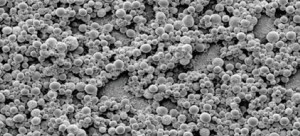Battery powered to heal
With its own first-aid kit, this battery can really keep going
With its own first-aid kit, this battery can really keep going.
Without batteries, we wouldn’t have cell phones, MP3 players or really portable laptops. All of our electronic devices would have to be plugged in all the time.

Batteries could survive longer if there were a way to patch those internal cracks as they form. And that’s the idea behind a new type of battery. In February, at the largest general science meeting in the United States, engineer Scott White introduced the invention: A battery that can heal itself.
Fixing those cracks and other battery problems “could help us make longer-lasting batteries,” White told Science News. White is an engineer at the University of Illinois at Urbana-Champaign.
The new device is a type of lithium-ion battery. These popular, rechargeable batteries are used in small electronics. They may also power electric cars one day. A lithium-ion battery has three basic parts. At one end is the cathode, which has a positive electric charge. At the other end is an anode, which is negatively charged. A liquid called an electrolyte carries charges between the cathode and the anode. In lithium-ion batteries, the electrolyte contains atoms of lithium that have positive charges. These charged atoms are called ions.
White and his colleagues knew that tiny cracks, which can often form in the anode, can block the electric current and eventually kill a battery. To combat the cracks, the scientists added a little something extra into the anode: tiny plastic bubbles, or spheres, filled with a material called gallium indium. When the anode develops tiny cracks, some of these bubbles break open and spill the gallium indium. This material can seal the crack, so that the battery can conduct electricity again — which means the battery will be back up and running.
The scientists say this idea can also be used to build safer batteries. Damaged lithium-ion batteries have been known to overheat and catch on fire.
“It’s not a common occurrence, but when it happens, the consequences are severe,” White told Science News.
He says another type of tiny sphere could be used to stop battery fires before they start. These bubbles, made from cheap plastic, are designed so that they melt if the temperature in the battery gets too high. Plastic does not conduct electricity. When the plastic bubbles melt, they stop the current within the battery, cooling it down.
“We’ve tested this in real batteries,” White told Science News. “It works beautifully.”
The benefits from longer-lasting batteries go beyond your cell phone. More charge means fewer replacements, which means fewer batteries in landfills. That’s good for the Earth.







